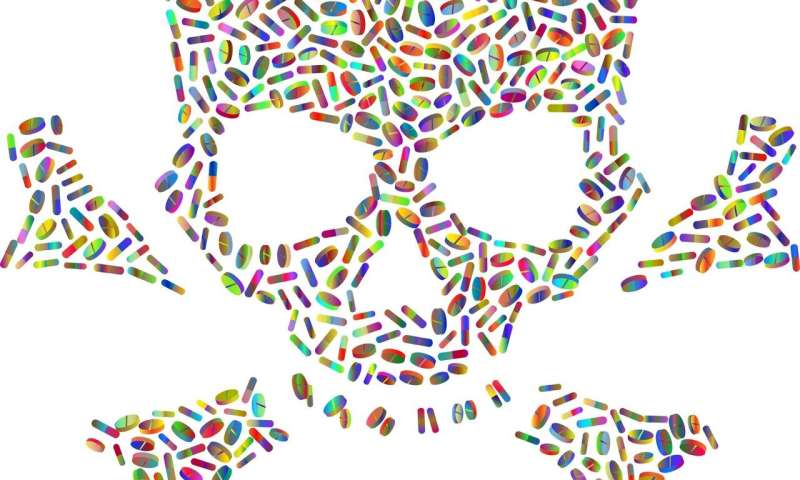
For people living with opioid use disorder, the path to treatment is not always clear-cut. Sometimes, there’s no path at all.
The gap between those recommended for medications for opioid use disorder—with methadone, buprenorphine or other medications prescribed—and those who ultimately receive it is wide and persisting. At the epicenter, accounting for more than one third of individuals with an opioid use disorder, are Medicaid recipients.
In an effort to gather information that might help to close that gap, researchers at the Brown University School of Public Health analyzed Medicaid databases to identify predictors of timely enrollment in treatment for those who experienced an opioid overdose or were diagnosed with opioid use disorder.
The findings, published in the journal Drug and Alcohol Dependence, show that 58% of Medicaid recipients did not enroll in treatment within six months of an overdose, and that prior overdose, alcohol use disorder and back problems were predictors of non-enrollment. Conversely, frequent visits to the emergency room or a primary care provider were associated with timely enrollment.
The researchers used multiple linked, state-level databases available through the Rhode Island Executive Office of Health and Human Services to conduct the study of 17,449 Medicaid recipients in Rhode Island.
“These findings underscore the need to enhance pathways to treatment, and we provide several recommendations to that end,” said Alexandria Macmadu, study author and a Brown doctoral candidate in epidemiology.
By pinpointing predictors of enrollment, and non-enrollment, researchers and physicians can get a clearer sense of where they need to connect with people to encourage treatment: in settings that provide mental health care, emergency departments, treatment programs for other substance use disorders, and even pain clinics.
Based on the findings, the researchers generated a two-tiered approach to enhance existing systems of care and ensure maximum exposure to pathways to treatment for OUD at the state level.
Interventions in these high-impact settings to improve screening for OUD and referrals to treatment are among the first steps in stemming the opioid epidemic, the researchers say.
“When it comes to treatment for opioid use disorder, we need to meet people where they are,” said Brandon Marshall, an associate professor of epidemiology at Brown and corresponding author of the study. “We can have the best treatment options out there, but they won’t do any good if we can’t deliver these options in a timely, accessible and non-judgmental way to everyone who might benefit.”
Because frequent visits to a primary care provider or emergency department were closely tied to receiving timely treatment, Macmadu said that’s a great place to start—and Rhode Island is already a national leader in that regard, she noted. Compared to other states, medications for OUD are easy to access, available when needed and covered by insurance. There are no waiting lists for the treatment, and enrollment has been growing steadily for several years, according to data from multiple state health agencies.
“Emergency department-based initiation is an incredible approach to use,” Macmadu said. “These findings have tremendous implications for other states that wish to replicate the increased engagement in treatment we’ve been able to achieve in Rhode Island.”
In addition to screenings and early interventions, Macmadu said that establishing on-demand buprenorphine induction—in which patients receive their first dose of the medication—at key facilities and incorporating peer recovery specialists—individuals who are in recovery themselves and can help to engage and support peers in the early stages of recovery—into overdose response are key to mitigating barriers to treatment.
Not all solutions are health care-based, however. Medicaid recipients tend to be lower-income than the broader population, and enhancing transportation support would have a remarkable impact their ability to receive the care they need.
“If you would like to engage in treatment, but you don’t have transportation, or you have to navigate the logistical issues of childcare, it can be incredibly difficult,” Macmadu said.
Above all, the researchers agree that the simplest, most impactful step toward stemming the tide of overdose is removing the stigma associated with medications for OUD.
Despite years of research that show medications for OUD are the most effective, evidence-based treatment, there is an enduring misconception among patients, physicians and the public that if a person is a patient at a methadone clinic, they’re still addicted to something, and that it’s not “real recovery,” Macmadu explained.
Kimberly Paull, director of data and analytics at EOHHS and one of the co-authors of the paper, said one of the most critical findings of the study was uncovered during focus group conversations with participants—that no improvement is possible if negative beliefs about medications for OUD persist.
Source: Read Full Article